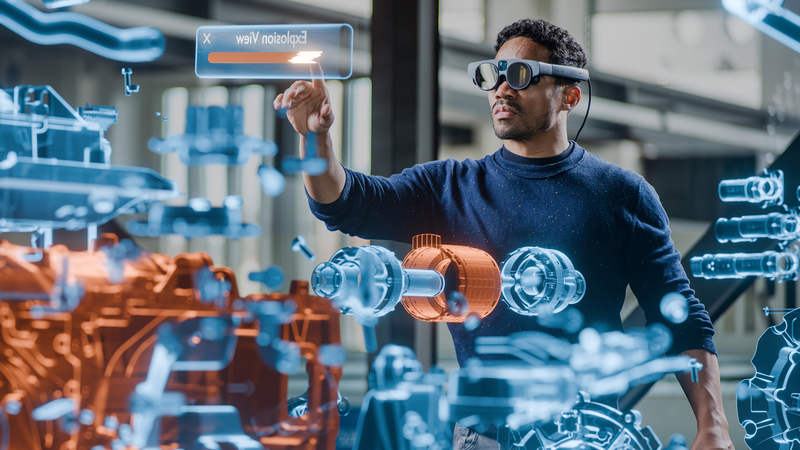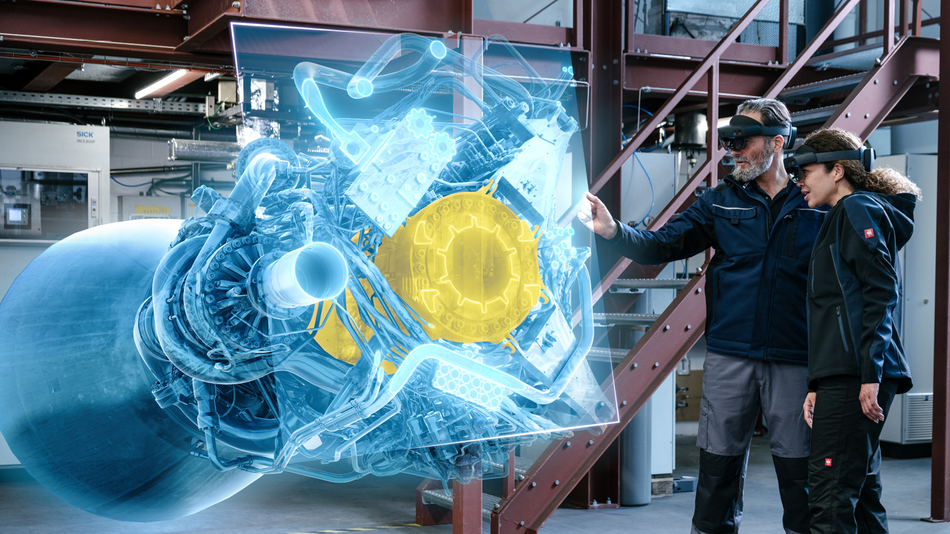How to Establish AR in Product Development?
Imagine a world where engineers can collaborate together on 3D holographic prototypes, manipulating them with ease, and where workers see real-time data superimposed on physical objects. This isn't science fiction; it's the transformative power of Augmented Reality (AR).
A new article series from XR software company Hololight demonstrates how AR can impact product development, showcasing its potential to radically change the way you bring products to life. In the six-part series, the authors discuss the technology's practical applications and guide you through the steps of implementing AR in your organization.
Whether you're a seasoned product developer, engineer, or just curious about the future of AR technology and product design, this series is your roadmap to leverage the power of immersive AR.
|
Article 1 – How Far can Augmented Reality Go?
Article 1 of the series shows the importance of digital continuity to ensure smooth data integration and utilization. It introduces the concept of immersive AR for 3D content, highlighting its potential to transform visualization in product design. With the help of AR glasses like Microsoft’s HoloLens 2 in combination with the right software, engineers can see and collaborate on 3D digital twins or prototypes in real-time. This allows for a more intuitive and faster way to develop products. This results in unprecedented application scenarios, including digital X-ray vision for process optimization, precise measurements, and improved fault diagnosis and correction.
The article makes clear the ways in which AR applications must adhere to the principle of digital continuity, ensuring that holographic 3D models match the source data down to the smallest detail.
Article 2 – How Do You Find Individual AR Use Cases for Product Development?
Article 2 of the series identifies specific use cases for AR within the product development lifecycle. The article shows how implementing immersive AR in product development is achievable for any company with existing 3D data. Analyze your product development process and identify areas where physical steps can be replaced with digital ones using AR.
Immersive AR plays two key roles:
Replacing Physical Prototypes: Digital prototyping is faster and cheaper than traditional methods like 3D printing or clay modelling. Designs can be easily updated and tested, leading to more rapid development cycles.
Cross-Site Collaboration: Teams around the world can collaborate on 3D holograms in real-time, eliminating travel time and streamlining communication. This collaborative approach extends to quality assurance and other downstream processes.
By reducing costs, prototype iterations, and travel time, AR helps companies bring products to market faster.
The article highlights the core principle of optimizing existing processes rather than creating entirely new ones. Start small and let your employees discover new use cases as they become familiar with AR's capabilities.
Article 3 – How Do We Ensure Occupational Safety & Technology Adoption?
The third article of the series tackles two key concerns for companies considering AR: worker safety and employee adoption.
Safety First
AR headsets come in various configurations, with some prioritizing safety features. Look for wireless devices with an open peripheral vision design that works indoors and outdoors and offers a flip-up display for maintaining situational awareness. Depending on your specific needs, other headsets might be suitable. Consulting with neutral experts ensures you choose the optimal hardware for your use case.
Building an AR Fan Club
Your company needs employees who are passionate advocates and champions for AR, promoting it internally.
Lead by Example: They should actively use and promote AR, showcasing its benefits across departments.
Speak Up: They should advocate for AR at external events, generating excitement and buy-in.
Focus on Results: They should back their claims with concrete examples and success stories from AR pilot projects.
Experience Days: Building Momentum
The article advocates for companies who are introducing AR to organize an "Experience Day" to foster internal support for AR. This event allows departments to showcase their AR projects, discuss challenges and benefits, and let everyone experience AR firsthand.
Sharing ideas and seeing AR in action creates an internal innovation network where employees learn from each other and discover new possibilities.
As employees witness the time-saving efficiency and frustration-reduction AR offers in their daily work, acceptance grows naturally. They'll even start proposing new uses for AR beyond product development, like logistics planning or factory design simulations.
Read the full article here
Article 4 – What about IT Integration and Data Security?
This article emphasizes using a "single source of truth" approach, where data is stored securely and accessed indirectly through AR applications. This ensures the original data remains protected.
For smooth integration and scalability, your AR platform should:
Support multiple devices, similar to how WhatsApp works on various smartphones.
Utilize streaming functionality - users access an interactive video stream of the AR application instead of running it locally on their device. This keeps the original data secure on a central server.
The article goes on to stress that high-quality, lossless streaming is essential for maintaining digital continuity (explained in Part 1) and integrating AR into your existing IT infrastructure. Most companies can leverage their existing network for AR streaming without needing a dedicated setup.
Article 5 – What is the ROI of AR?
Article 5 of the series dives into the return on investment (ROI) you can expect from AR. Here's the key takeaway: AR can pay for itself within months by saving time, materials, and travel costs.
Identifying AR's Impact
Look for processes where AR can replace physical steps (e.g., 3D printing prototypes) or real materials (e.g., physical prototypes themselves). These areas hold the most ROI potential.
Once you implement AR for a few initial use cases, it becomes easier to identify further optimization opportunities. As experience grows, the cost per AR project decreases, leading to a faster return.
Measuring Success
Companies can track ROI at various stages of product development. Here are some key metrics discussed in this article:
Time saved through collaborative work on digital prototypes
Material savings from using virtual models
Prototype iteration speed compared to traditional methods
Number of defects found and fixed in prototypes
Reduced travel time
Article 6 – Who Will Drive AR Technology in the Future?
This final article of the series discusses leadership and the future of AR in business.
AR Adoption: Beyond Initial Steps
While getting started with AR is easy, true transformation requires executives' commitment. Leaders with a long-term vision must champion AR and integrate it across various business processes.
Ownership and Vision
Clearly define ownership of AR projects and the overall "Industrial Metaverse" strategy. This fosters enterprise-wide adoption.
Titles like "Mixed Reality Solutions Lead" or "Chief Metaverse Officer" reflect the growing importance of AR leadership.
The Industrial Metaverse Advantage
Companies that embrace AR now gain an "early adopter" advantage, similar to those with an early web presence in the 90s.
Immersive AR is the key to entering the Industrial Metaverse, a future where virtual and real worlds converge across all business areas.
Final Words – Stepping into the Industrial Metaverse with AR
This six-article series will equip you with a comprehensive understanding of how Augmented Reality (AR) can revolutionize product development. We've explored the technology's potential, from creating immersive 3D prototypes to fostering collaborative design across teams.
By adopting AR now, companies gain a significant advantage. AR is a gateway to the "Industrial Metaverse," where immersive technologies will transform how businesses operate.
Check out the informative webinar from Hololight to learn more about the opportunities associated with implementing AR within your business.
What you’ll learn
Explore detailed methodologies on how AR can significantly reduce your time to market and lower prototype expenses. The webinar provides insights into the cost-saving mechanisms enabled by AR.
Learn about AR's capabilities in improving communication and collaboration among engineering teams. The session covers specific tools and techniques that facilitate more efficient project execution.
The webinar includes technical discussions on the scalability and adaptability of AR solutions.
How to Access the whitepaper
Accessing the whitepaper is straightforward. Register below and gain immediate access to this valuable resource.
This article was edited by Hiba Akbar.

